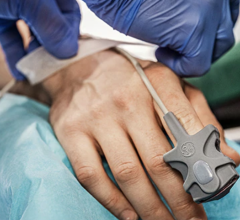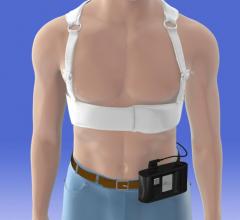
January 22, 2018 — The U.S. Food and Drug Administration (FDA) announced last week it is providing information and recommendations regarding the Zoll LifeVest 4000 due to concerns that the device may fail to deliver treatment to the patient if the device is not replaced soon after displaying "Call for service: Device has a problem that may require service. Call Zoll for service, Message Code 102." Failure to contact Zoll and immediately replace the device after Message Code 102 appears on the device screen may result in serious patient harm or death of the patient because the device may fail to deliver therapy appropriately when needed.
Ideally, the LifeVest monitors the patient's heart, delivering a "treatment shock" as needed to restore the patient's heartbeat to a normal rhythm. However, FDA is aware that in certain cases the LifeVest 4000 may not be able to deliver a life-saving treatment shock to a patient due to a fault that prevents the device from charging its high-energy capacitors. During normal operation, this fault prompts the LifeVest to display "Call for service: Device has a problem that may require service. Call Zoll for service, Message Code 102" on the device screen. The "Message Code 102" alert does not explicitly indicate to the patient that the device cannot be used and that the patient should call Zoll immediately.
To date, FDA is aware of one patient death due to the LifeVest's failure to deliver treatment as expected after Message Code 102 was displayed. According to Zoll, as of Nov. 14, 2017, there were a total of 33,670 devices distributed, with 24,975 devices distributed in the U.S. About 0.1 percent of the total devices distributed have displayed Message Code 102, which should only be remedied by immediate replacement of the device.
The FDA will continue to work with Zoll to monitor LifeVest 4000 devices for any adverse events related to Message Code 102 or a failure to deliver treatment. The agency will also continue to work with Zoll to identify a permanent solution to the Message Code 102 issue, and will keep the public informed as new information becomes available.
The Zoll LifeVest 4000 is a wearable defibrillator used to treat life-threatening arrhythmias in adults and children who are at risk for sudden cardiac arrest and are not candidates for, or refuse, an implantable defibrillator. The LifeVest continuously monitors the patient's heart and, if a fast, life-threatening heart rhythm is detected, the device delivers a treatment (i.e. a shock) to restore the patient to a normal heart rhythm.
The FDA’s recommended actions for healthcare providers include:
- Train patients prescribed use of the Zoll LifeVest 4000 on how to identify the "Call for service, Message Code 102" alert. Message Code 102 may first display as a gong alert, and then subsequently at every power-up until the device is returned to Zoll for servicing. The alert will read "Call for service: Device has a problem that may require service. Call Zoll for service, Message Code 102" and will allow the patient to tap "OK" to return to normal operation;
- Inform patients to respond to the "Call for service, Message Code 102" alert on the LifeVest 4000 screen by contacting Zoll immediately. Message Code 102 may mean that the LifeVest 4000 has a severe service problem and cannot be used because the device may not appropriately deliver life-saving treatment if needed. Zoll will replace the patient's device within 24 hours if the device displays Message Code 102. Zoll's Customer Service can be reached 24 hours a day, and 7 days a week at 1-800-543-3267; and
- Reinforce initial LifeVest 4000 training, explaining that the device can display messages on the screen and play audio alerts that require the patient to take action. If Message Code 102 does not appear on the device screen, the patient should continue to use the LifeVest 4000 as prescribed, and read the display for gong alerts and follow the instructions on the screen (refer to Section 5 in the Patient Manual).
Recommendations for patients and caregivers include:
- Contact Zoll immediately if "Call for service: Device has a problem that may require service. Call Zoll for service, Message Code 102" appears on your LifeVest 4000 screen. Message Code 102 may first display as a gong alert, and then subsequently at every power-up until the device is returned to Zoll for servicing. The Message Code 102 alert will also allow you to tap "OK" to return to normal operation;
- However, the "Call for service, Message Code 102" alert may mean that the LifeVest 4000 has a severe service problem and cannot be used because the device may not appropriately deliver life-saving treatment if needed.
- Zoll will replace your device within 24 hours if the device displays Message Code 102. Zoll's Customer Service can be reached 24 hours a day, and 7 days a week at: 1-800-543-3267.
- Continue to use your LifeVest 4000 as prescribed by your physician and as instructed during your initial training if the "Call for service, Message Code 102" alert is NOT displayed on your device screen. You should continue to read the display for gong alerts and follow the instructions on the screen (refer to Section 5 in the Patient Manual).
Healthcare professionals and patients are encouraged to report adverse events or side effects related to the use of these products to the FDA's MedWatch Safety Information and Adverse Event Reporting Program:
- Complete and submit the report Online: www.fda.gov/MedWatch/report
- Download form or call 1-800-332-1088 to request a reporting form, then complete and return to the address on the pre-addressed form, or submit by fax to 1-800-FDA-0178
For more information: www.fda.gov


 July 28, 2023
July 28, 2023 








